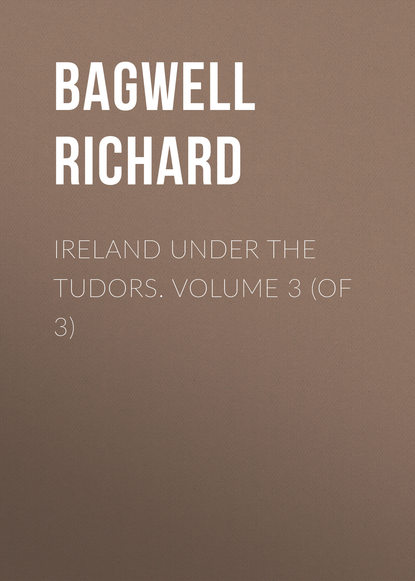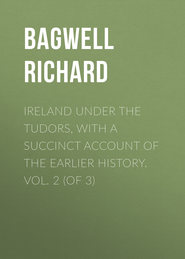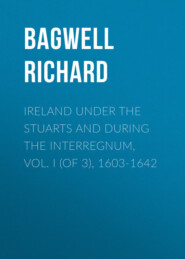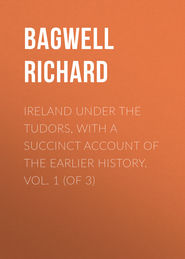По всем вопросам обращайтесь на: info@litportal.ru
(©) 2003-2024.
✖
Ireland under the Tudors. Volume 3 (of 3)
Настройки чтения
Размер шрифта
Высота строк
Поля
288
Four Masters, 1598. Sir C. Clifford to the Lords Justices, Sept. 7; to Cecil, Oct. 30; Lady Clifford’s declaration, Oct. 31.
289
Lords Justices and Council to the Privy Council, Nov. 23 and 27, 1598. Sir R. Bingham to the Lords Justices (from Naas) Nov. 27. There is a MS. dialogue among the Irish S.P. for 1598, which purports to be the ocular testimony of the writer, Thomas Wilson, and which is dedicated to Essex. The interlocutors are Peregryn and Silvyn – the names of Spenser’s two sons – and the dialogue, which unfolds the state of things in King’s County from harvest 1597 to All Saints’ Day 1598, is very much in the style of that between Irenæus and Eudoxus. Is Thomas Wilson a stalking-horse for Edmund Spenser?
290
Four Masters, 1598; O’Sullivan, tom. iii. lib. v. cap. 2; Discourse by William Weever (prisoner with the Munster rebels) Sept. 29 to Oct. 10. Fenton to Cecil, April 20, for the Tower story.
291
Ormonde to James Fitzthomas, Oct. 8, 1598; James ‘Desmonde’ to Ormonde, Oct. 12.
292
Ormonde to the Queen, Oct. 12, 1598; Chief Justice Saxey’s account, October.
293
List of castles abandoned without resistance in Ormonde’s letter to the Queen, Oct. 21, 1598; Oliver Stephenson to Norris, Oct. 16; Henry Smyth’s State of Munster ‘as I did see and hear it,’ Oct. 30. An anonymous paper of October gives some details of Raleigh’s settlement at Tallow. See also James Sarsfield, mayor of Cork, to the Privy Council, Oct. 21.
294
Arthur Hyde to the Privy Council, Oct. 28, 1598; Captain F. Barkley to the Lords Justices, Nov. 3.
295
Sir T. Norris to the Privy Council and to Cecil, Oct. 23, 1598; W. Weever’s discourse, Oct.; Chief Justice Saxey’s account, Oct.; the Queen to Ormonde and the Lords Justices, Dec. 1, and to Norris, Dec. 3; Moryson, book i. chap. i.; O’Sullivan, tom. iii. lib. v. caps. 1-5; Four Masters, 1598. Dunqueen is close to Slea Head, the westernmost point of Kerry.
296
Ormonde to the Privy Council, Nov. 5, 1598; Edward Gough and George Sherlock to Sir N. Walshe, Nov. 16. Gough and Walshe held Cistercian lands at Innislonagh and Glandore; Sherlock had those of the Canons Regular at Cahir; but none of the three bore Protestant names.
297
Ormonde to the Privy Council, Nov. 5, 1598; to the Queen, Jan. 19, 1599; the Queen to Ormonde and the Lords Justices, Dec. 1, 1598, in Carew. Bingham’s appointment as Marshal was announced on Aug. 31, only seventeen days after Bagenal’s death. He reached Ireland in October, and died at Dublin, Jan. 19. A memorial by Cecil, dated Nov. 4, 1598 (in Carew, p. 523), has the words ‘Clifford betrayed, Bingham lightly condemned.’ Bingham’s Irish patent is dated Oct. 13, and the Queen informed the Lords Justices that she had specially chosen him, that he was to draw pay and allowances from the day of Bagenal’s death, and that he was to have all the privileges that had ever attached to the office. Morrin’s Patent Rolls, 40 Eliz. 57 and 58.
298
Four Masters, 1598 and 1599. The Queen to Sir T. Norris, Dec. 3, 1598, in Carew.
299
Four Masters, 1599. For Con O’Neill see Carew, March and April, Nos. 299-301; Journal of Sir T. Norris, from March 27 to April 4; Justice Golde to Essex, April 4; Essex to Privy Council, April 29. Lord Roche had a private quarrel with the Sugane Earl.
300
Parallel between Essex and Buckingham in Reliquiæ Wottonianæ.
301
Reliquiæ Wottonianæ; Camden; Essex to the Queen in Devereux’s Earls of Essex, i. 493. The letter quoted in the text is the best proof that Camden’s story is substantially true. See also Spedding’s Life of Bacon, ii. 91, 103. For Spanish popular notions on Philip III. see Carew, Aug. 23, 1602. Beaumont, the French ambassador in 1602, says the Queen told him, in a broken voice, that she had warned Essex long since ‘qu’il se contestast de prendre plaisir de lui déplaire à toutes occasions, et de mepriser sa personne insolemment comme il faisait, et qu’il se gardast bien de toucher à son sceptre.’ – Von Raumer, Letter 60.
302
Spedding, ii. 124-126; Essex to John Harrington in Park’s edition of Nugæ Antiquæ, i. 246.
303
Bacon’s advice to Essex immediately before his going to Ireland, Spedding, ii. 129; Essex to Southampton, Jan. 1, 1599, printed by Abbott; Bacon’s Apology, first printed in 1604.
304
The letter of advice is in Spedding, ii. 129; Apology concerning the Earl of Essex; Essex to Southampton in Abbott’s Bacon and Essex, chap. ix. Jan. 1, 1599. Essex wrote to the Queen, just before starting, as follows: ‘From a mind delighting in sorrow, from spirits wasted with passion, from a heart torn with care, grief, and travail, from a man that hateth himself and all things also that keepeth him alive, what service can your Majesty expect? since my service past deserves no more than banishment and proscription into the cursedst of all other countries.’ The letter ends with some verses in praise of a contemplative life, and Essex signs himself ‘your Majesty’s exiled servant.’ —MS. Harl. 35, p. 338.
305
The progress of the negotiations may be traced in Chamberlain’s Letters (Camden Society). Essex to Southampton, Jan. 1, 1599; and Charles Blount (afterwards Lord Mountjoy) to Essex, Jan. 3, both in Abbott, chap. ix.
Full little knowest thou, that has not tried,
What hell it is in suing long to bide;
To lose good days that might be better spent
To waste long nights in pensive discontent;
To speed to-day, to be put back to-morrow, &c.’ —Spenser.
306
Devereux, ii. 16-24; Four Masters; Prayer for the good success of Her Majesty’s forces in Ireland (black letter, London, 1599).
Were now the general of our gracious empress
(As in good time he may), from Ireland coming,
Bringing rebellion broached on his sword,
How many would the peaceful city quit,
To welcome him? —Henry V. Act 5.
307
Chamberlain’s Letters, 1599. Robert Markham to John Harrington in Nugæ Antiquæ, i. 239; Fenton to Cecil, May 7; Fynes Moryson’s Itinerary, part i. book i. ch. i. At Hatfield there are a great many letters asking Essex to employ the writers or their friends in Ireland. Most of these anticipate triumph. William Harborn on Feb. 3 asks for nothing, but presents the Earl with an Italian history of the world in four volumes, ‘to attend your honour, if they be permitted, in this your pretended Irish enterprise, at times vacant to recreate your most heroical mind.’ The Queen’s instructions speak of a ‘royal army, paid, furnished, and provided in other sorts than any king of this land hath done before.’ Its nominal strength was raised to 20,000, but they were never really under arms at once.
308
The Commission, dated March 12, is in Morrin’s Patent Rolls, ii. 520. The instructions, dated March 27, are fully abstracted by Devereux, and in Carew.
309
Chichester to Cecil, March 17, 1599, MS. Hatfield. Account of Sir Arthur Chichester by Sir Faithful Fortescue in Lord Clermont’s privately printed Life of Sir John Fortescue, &c.








